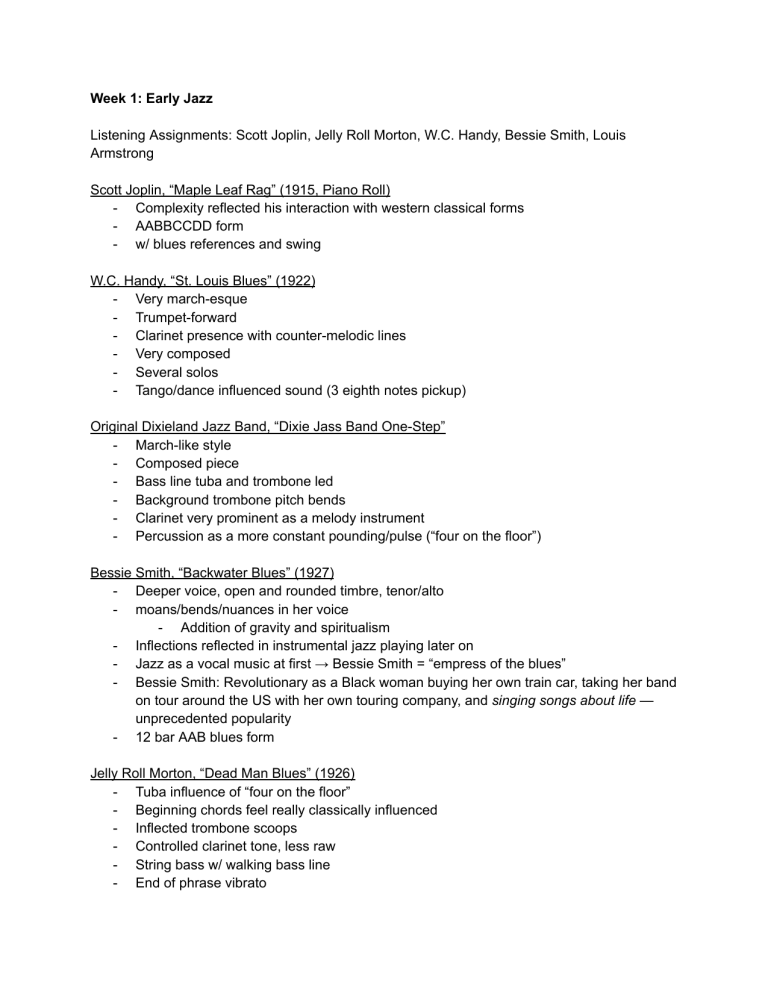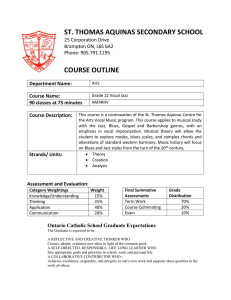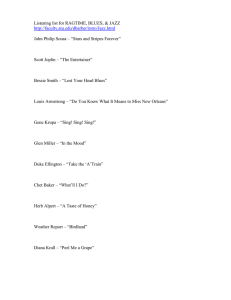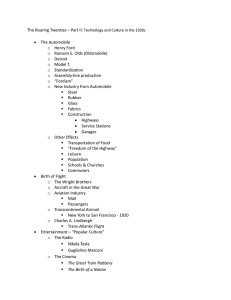
Week 1: Early Jazz Listening Assignments: Scott Joplin, Jelly Roll Morton, W.C. Handy, Bessie Smith, Louis Armstrong Scott Joplin, “Maple Leaf Rag” (1915, Piano Roll) - Complexity reflected his interaction with western classical forms - AABBCCDD form - w/ blues references and swing W.C. Handy, “St. Louis Blues” (1922) - Very march-esque - Trumpet-forward - Clarinet presence with counter-melodic lines - Very composed - Several solos - Tango/dance influenced sound (3 eighth notes pickup) Original Dixieland Jazz Band, “Dixie Jass Band One-Step” - March-like style - Composed piece - Bass line tuba and trombone led - Background trombone pitch bends - Clarinet very prominent as a melody instrument - Percussion as a more constant pounding/pulse (“four on the floor”) Bessie Smith, “Backwater Blues” (1927) - Deeper voice, open and rounded timbre, tenor/alto - moans/bends/nuances in her voice - Addition of gravity and spiritualism - Inflections reflected in instrumental jazz playing later on - Jazz as a vocal music at first → Bessie Smith = “empress of the blues” - Bessie Smith: Revolutionary as a Black woman buying her own train car, taking her band on tour around the US with her own touring company, and singing songs about life — unprecedented popularity - 12 bar AAB blues form Jelly Roll Morton, “Dead Man Blues” (1926) - Tuba influence of “four on the floor” - Beginning chords feel really classically influenced - Inflected trombone scoops - Controlled clarinet tone, less raw - String bass w/ walking bass line - End of phrase vibrato - Celebratory Dialogue at the beginning as reflective of minstrel shows, parody of black conversation Louis Armstrong, “West End Blues” (1928) from Louis Armstrong and His Hot Five - Strong end of phrase vibrato - Trumpet and singing mirrored - Cadenza really highlights the soloist - “Hot” style/sound - Woodblock percussion? Week 2: The Big Bands Listening Assignments: Count Basie, Duke Ellington, Coleman Hawkins, Billie Holiday, Ella Fitzgerald Duke Ellington, “Take the A Train” (1941) - Saxophone forward in the melody + saxophone soli - String bass walking line - Embellishment responses of trumpets - Trumpet w/ a mute → sounds like a vocalist - 32 bar AABA form - Moaning Ellington effect - Big band era (tail end) - Composed piece Duke Ellington, “Cotton Tail” (1940) - Unison vs. conversational back and forth between reeds and brass - Each section really functions as one - E.g. saxophone soli - Walking string bass line - Four on the floor - saxophone solo with trumpet hits → increasing prominence of saxophone as a jazz solo instrument (Ben Webster, on this recording) Count Basie, “One O’Clock Jump” (1937) - Head arrangement - New instruments come in in layers - Consistent guitar comping patterns - A lot of note and theme repetition → the riff all throughout - A blues composition - Melody comes at the very end - More lilting, not as much directionality as ellington - Lighter sound, piano plays a big role Count Basie/Lester Young, “Oh! Lady Be Good” (1936) - Very intentionally placed vibrato from Lester Young (sort of like Louis Armstrong) - Identity of the tenor sax in jazz coming out - Same lighter rhythm section - Timbre of the saxophone pops out more Coleman Hawkins, “Body and Soul” (1939) - Almost a trumpet style of playing the tenor sax, especially with a very eager upper register - Vertical arpeggios, outlining chord changes clearly - Very strong vibrato - Use of the full range of the instrument Benny Goodman, “Sing Sing Sing” (1937) - Longer duration (8 mins) was an extended work that used both sides of a record - This provided more opportunities for innovative / creative soloing from individual musicians → more individual solos (clarinet, drums, tenor sax, trumpet… etc.) - “King of Swing” white Jewish clarinetist - Each section moving as one (trumpets together, saxophones together, etc.) Billie Holiday, “God Bless the Child” (1942) - Very placed vibrato - Rich, covered tone - Pitch inflections - Carefully constructed connections between words - Flute! - Arrangement sounds like it was made for her voice, framing her Ella Fitzgerald, “Blues Skies” from Ella Fitzgerald Sings the Irving Berlin Songbook - A lightness and effortlessness to her vibrato phrase ends and vocal timbre - Scatting: - Lots of variation in articulation and connection - Pitch inflections sound very instrumental - Timbre just like her voice when singing lyrics (seamless transition from scatting to singing) - Playing with time - sometimes behind the beat - Not just imitating instruments, but expanding what can be done through her voice - Exceptional sense of rhythm, improv and melody - Quoting other pieces as well — pulling influences spur of the moment Week 3: Bebop Listening Assignments: Charlie Parker, Dizzy Gillespie, Bud Powell Charlie Parker and Dizzy Gillespie, “Dizzy Atmosphere” (Live) from Diz N’ Bird at Carnegie Hall - Super fast tempo (typical of bebop) - Charlie Parker’s signature “flying” sound (hence “bird”) - Clear demarcation between solo / group sections - New chords/tones, more complicated harmonies - Charlie Parker’s signature clean, edgy sound Charlie Parker, “Ko Ko” from The Complete Savoy Recordings - Again, speedy tempo - Melodies and run sound improvised - Fleeting / rapidly changing harmonies - Melody makes another return in the end Charlie Parker, “Parker’s Mood” from The Complete Savoy Recordings - Blues (?) - Melodies are still very runny/flying, but much less active - Rhythmic complexity in runs, combining various different subdivisions of the beat in one measure Bud Powell, “Tempus Fugue-it” from Jazz Giant - Repetition of certain riffs and patterns - More dissonance - Classical influence in lower notes - Much faster pace reinforced by the drummer (not much if any bass drum, lighter snare and cymbals) - Fugue → like baroque music Early Jazz (Ragtime, etc) - Jazz started out as a vocal tradition - March-like — often like marching bands in instrumentation - Greater gap between black and white artists → black musicians weren’t the ones benefiting from their art - Mix of African musical antecedents: - Polyrhythms → syncopation - Conversational call-and-response - Bent and inflected notes - Contained classic tuba baseline - Danceable music - Ragtime = Ragged time → a style of playing piano or banjo where melody is broken up into short syncopated rhythms all over a steady overall beat Blues - 12 bar blues progression Blues scale included pentatonic and tritone → non-European features AAB format Mostly vocal tradition at first The Big Bands/Swing - Became the popular music of the time - Stayed in popularity for a long time because of the cultural lag between black and white artists - During this time, bandleaders like Benny Goodman first decided to subvert race in having a ‘colorblind’ approach to selecting musicians for their ensembles - Meant to be danced to - Drum and Bass focused baseline Bebop - The start of “Modern Jazz” in the 40’s - Post WW2 music & before Civil Rights era - A counterculture to make new music, new harmonies, new tones, etc - Fight back against mainstream commercialism that bebop artists thought swing had become - This also came with a change in dress and talk - Zoot suit - Jive talk - Goatee - Fast speed (not meant to be danced to), showcasing individual musicians’ virtuosity Singer Musician Jazz Musicians/Groups/Places Scott Joplin (1868 - 1917): - Famous Ragtime performer Dixie-land Jazz Band (1917 - 1920s): - First commercially releases Jazz Band - Four on the Floor - Melodies are very composed New Orleans - Birthplace of Jazz - “Congo Square” - Home of Louis Armstrong - N.O. musicians resembled Marching Bands - Tubas, Trumpets, Clarinets, Trombone … BB King (1925 - 2015): - One of greatest Blues Artist “Jelly Roll” Ferdinand Morton (1890 -1941): - Classically trained but also played Jazz - More “European”-style of music - Formed “Red Hot Peppers” “Empress of the Blues” Bessie Smith (1894 - 1937): - Helped create branching out point in Blues to Jazz - Deep tenor, powerful voice - “Beyonce” of her time - Subject matter of music was about real life - Funded her own tour around the U.S. Louis Armstrong (1901 - 1971): - Distinct musical style that set him apart as the “first great soloist” - Delayed vibrato - Influenced the improvisation of instruments - First Jazz musician to skat - Represents “Old School Jazz” / “old Negro” - Singing resembled trumpet - Brought jazz out of “race records” “Count” William Basie (1904 - 1984): - Musically diametrically opposed to Ellington - Very simplistic composition style — lighter sound achieved through less use of bass drum, with more piano - Four on the Floor replaced with hi-hat emphasis - Head arrangements / head compositions - Making up a tune with riffs that later crystallize, in a collectively improvisatory manner “Duke” Edward Kennedy Ellington (1899 - 1974): - Epitome of “New Negro” - Born upper middle class - Handsome, wealthy, well-mannered - Insisted on seriousness and being taken seriously / respected - Didn’t like name of Jazz; called it “zzaj” - “The Ellington Effect”: melody made to draw out attention; “moaning” of instrument, usually in the background of a melody - Became a great composer (complex, complicated harmonies etc) through Cotton Club, where he got to experiment with abstractions, nonfunctional music, etc. - Loved the sound of train (“Daybreak Express”, “Take the A Train”) Billie Holiday (1915 - 1959): - “Lady Day” - Way she used her voice was like playing an instrument - Vocal accenting, pitch inflections, articulation - Very intentionally placed vibrato - Dealt with substance abuse - Famously sang “Strange Fruit” (1939) about lynching - Protest song influence by Bessie Smith Ella Fitzgerald (1917 - 1996): - Discovered in Harlem, Apollo amateur night at age 17 - 4-octave vocal range - the master of scat singing - Not just imitating instruments, but expanding what could be done through scatting and her voice The Big Three “Hawk/Bean” Coleman Hawkins (1904 - 1969): - Jazz saxophonist - “Vertical” playing style, lots of arpeggios - Heavier, longer melodic lines “The Prez.” Lester Young (1909 - 1959): - Musical style: - Much lighter, husky/breathy sound - Warm subtone sound on lower register - Smooth, legato playing - Harmonic and rhythmic sophistication - No vibrato - Improvisation: Linear playing, unfolding narrative quality - “Told a story” - Small elements of melodic material strung together creatively Ben Webster (1909 - 1973) Art Tatum (1909 - 1956): - Pianist - Main inspiration: Stride pianists - Born legally blind - Very busy playing - Ragtime influences over swing “King of Swing” Benny Goodman Minton’s Playhouse: - Birthplace of Bebop Thelonious Monk (1917 -1982): - Largely self-taught pianist - A leader in the Bebop movement - Child prodigy - Suffered from mental illness - Used a lot of tritones - Used a lot of whole tone scales Charlie Christian (1916 - 1942): - Electric Guitarist - Distinct and clean playing - Long horn-like lines - Rhythmic riff figures Kenny Clarke (1914 - 1985): - The first bebop drummer - Lighter drums - Accented Charlie Christian’s rhythms - “Dropping bombs” — unexpected accents Jimmy Blanton (1918 - 1942): - Landmark bassist - inspiration for Charles Mingus and other later bebop bassists - Very prominent bass sound - Made the bass a solo instrument - Where there’s more space in the arrangement, playing faster notes to fill the space Roy Eldridge (1911 - 1989): - Trumpet player, link between Louis Armstrong and Dizzy Gillespie - Greater range (higher pitches with ease), diving and leaping - Developments in technique and range “Dizzy” John Gillespie (1917 - 1993): - Famous for his upturned trumpet and puffed-out cheeks - Incredible upper register playing - More melody-focused, even within bebop (melody > rhythm) - Really thinking about longer phrases, taking very short breaths in his bebop playing “Bird” Charlie Parker (1920 - 1955): - “Flying” musical style - Clean, bright, almost edgy saxophone playing - Sound innovator: changed the way jazz sounded, esp. on alto sax - Big fan of classical music Heroin addict Bud Powell (1924 - 1966): - Influenced by Art Tatum - Had schizophrenia, and was hit in the head with a billy club - “Glass Enclosure” → first piece in jazz to use slash chords (which became more prominent in the 1960s) Sonny Stitt (1924 - 1982): - Sounded like Charlie Parker Wynton Marsalis (1961 - ): - American trumpeter, composer, teacher, and artistic director of Jazz at Lincoln Center - won nine Grammy Awards Miles Davis - Went to Julliard - Trumpet player - Friends with Thelonious Monk Order of Evolution: Hymn/Spiritual → Ragtime → Jazz (Blues → Swing/Big Band Jazz → Bebop…) Musical Terms ● Arpeggio ● Soli: “ A directive to perform the indicated passage of a composition with an entire section of an ensemble” ● Altissimo: notes going above the natural register of the instrument ● Contrafact: music melody written on top of the harmony ● AABA: order of musical theme ● Riff: musical phrase that repeats itself ● Timbre: quality of sound ● Swing: emphasis on 2 and 4 / groove ● Shout Chorus: common theme played behind the beat ○ Tension is created by pulling the beat behind ● Subtone: technique used with Saxophone to emphasize lower register of notes ● Head Arrangement: roughly outlined musical arrangement played from memory, collectively improvised during a performance (generally based on a certain riff as thematic melody) ● “Four-on-the-floor”: emphasis of every beat ● Scat singing: singing nonsensical syllables in order to imitate the articulation and nuances of instrumental playing ● ● ● ● ● “Dropping bombs”: The Ellington effect: moaning reed sounds under a soloist, often used by Duke Ellington in his compositions Slash chords: “indicates emphasis of a bass note other than the root of the chord” New vs. Old Negro: ○ Old – Louis Armstrong, a version of African-American Harlem Renaissance artists wanted to get away from, always smiling/dancing, entertaining (not taken seriously) ○ New – Duke Ellington, serious, dignified, respected, not just for entertainment Race Records: jazz styled to be targeted towards certain races ○ Vs. Louis Armstrong, who internationalized jazz and brought it to everyone




